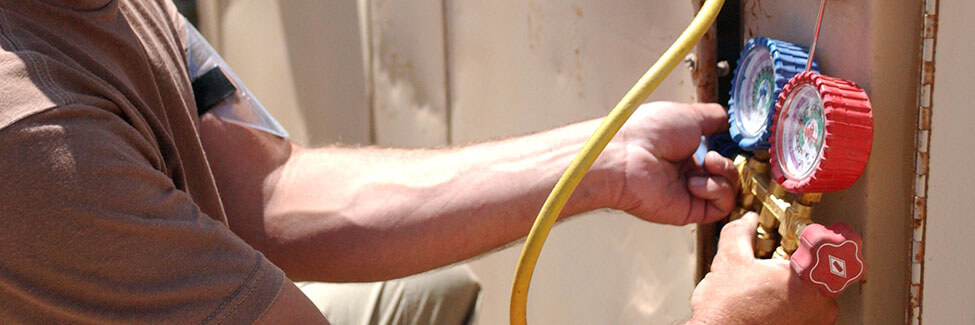
The HVAC Glossary – Top Heating, Cooling, and Ventilation Terms You Should Know
Knowing heating, ventilation, and air conditioning (HVAC) term definitions is important for anyone working with HVAC systems, especially technicians, in order to understand how those systems work and provide top quality service.
These terms are used in technical documents, manuals, and specifications, so we’ve assembled a comprehensive list of terms for reference to make your job that much easier:
Air Changes Per Hour (ACH)
Air changes per hour measure the times air is cycled through a space in a 60 minutes, often used when comparing air purifiers. The higher the ACH, the more quickly an air system will be able to impact the quality of your air.
Air-Conditioning Unit (AC Unit)
An air-conditioning unit is a device that cools and dehumidifies the air in your home. AC units may be permanent appliances in a home or temporary (often as portable or window units). Air-conditioning units are used to maintain a comfortable temperature for the occupants of a building.
Air Ducts
Air ducts are used to distribute air throughout the building. They connect an HVAC system to the rooms in the building. Air ducts can be made of different materials, including metal or plastic. They are usually covered with a plastic or metal sleeve to prevent them from being damaged by other objects in the room.
Air Filter
An air filter is used to clean the air in your home. It is usually located in an air duct or air purifier and is used to trap dust, pollen, and other particles that might affect your health. You should regularly clean or replace most air filters. To improve performance and longevity
Air Handler
An air handler is a device that moves air throughout a building. They are powered by electricity and can contain multiple elements. Air handlers are generally large boxes that work with heating and/or cooling appliances, containing a blower fan as well as an evaporator coil.
Air Purifier
Air purifiers are appliances that remove particles (dust, hair, pollen, bacteria, etc.) that affect lungs, irritate airways, and worsen allergies. Air purifiers pass these particles through highly efficient air filters to improve air quality. These devices are often shaped like sophisticated portable fans and come in both domestic and industrial models.
Alarm System
An alarm system is used to alert you if someone breaks into your home or if there is an emergency in your home. You can also use an alarm system to alert you if there is an intruder in your home when you are not there. An alarm system can be activated by motion sensors, smoke detectors, water sensors, or other devices that detect changes in temperature, sound, light, or other conditions in your home that might indicate an emergency has occurred.
Alarm System Controller (ACU)
An alarm system controller is a device that controls all of the components of an alarm system and monitors their status at all times. It can be used to activate the alarm if any component fails, and it can also be used to deactivate the alarm if any component fails. An alarm system controller can also be used to monitor all components of an alarm system at all times and report their status back to you via a display screen and/or speakers on your phone, tablet, computer, or other device.
British Thermal Unit (BTU)
British Thermal Units (BTUs) are a measurement of energy required to change temperature, frequently used when discussing heaters or air conditioners. One BTU is defined as the amount of energy required to raise the temperature of one pound of water by one degree Fahrenheit. Now, heater and air conditioner manufacturers use BTUs to make it easier to compare heaters with different capacities and designs. In general, the larger the number of BTUs, the higher the capacity of the appliance. For example, a 1,000-BTU heater will use more energy than one with 200 BTUs.
Central Air Conditioner
Central air conditioners are more complex and larger than window or portable air conditioners. They cool air through an entire building, rather than just one room, and they use a fan with ductwork to move the air from one place to another.
Chiller
Chillers are devices that cool a liquid, usually through some sort of refrigeration cycle. They’re used in HVAC to help maintain the temperature of the air in a building by removing that heat in strategic places like basements or rooftops.
Condenser
Condensers are the part of an appliance that transfers heat from the refrigerant to the air. They’re often made of copper or aluminum. Refrigerant is passed to the condenser as a high-pressure gas, where it rapidly moves through fins and heat is radiated away, turning the gas into a liquid, getting rid of heat quickly and efficiently. That liquid then hits the expansion valve, where both temperature and pressure decrease.
Compressor
The part of an appliance that compresses refrigerant to create a high-pressure gas. Compressors are usually powered by electric motors and located near the condenser.
Dehumidifier
A dehumidifier is a device that removes moisture from an indoors pace. These are used in homes, commercial buildings, and industrial facilities to help prevent mold, mildew, and dust mites from spreading.
Dryer
A dryer is a machine that dries clothes by heating them up and causing them to evaporate moisture. These machines are used in homes and businesses to make clothes more comfortable to wear.
Ductless Mini-splits
Ductless mini-splits are HVAC systems that have no ducts or vents, but instead have small indoor units that use heat or cool air to heat or cool a room or area. Ductless mini-splits can be combined with other HVAC systems such as packaged units or split-systems to make more efficient use of space and reduce energy consumption.
Evaporator
The evaporator is the part of an appliance that transfers heat from the refrigerant to the air. It is made of copper or aluminum and is located above the compressor in the evaporator coil. The evaporator is usually a coil of tubing with fins that cools the refrigerant.
Evaporative Cooler
Evaporative coolers are appliances that pass air through water-saturated pads, bringing down the temperature and adding moisture to the environment. Often called “swamp coolers,” these alternatives to air conditioning work well in dry areas with low wet-bulb temperatures.
Expansion Valve
A device used to regulate the flow of refrigerant through an expansion valve, which regulates pressure in a system and allows it to work efficiently.
Fresh Air Intake
The air intake is the opening that allows fresh air to enter an indoor space from the outside.
Heater
A heater is an appliance that heats air and is used in heating systems. Heaters can be used to warm up a room or entire house as needed, or they can be used to heat water for bathing or showering. There are also space heaters that are used to warm up small areas, like closets or garages.
Heating System
A heating system is made up of all the appliances that work together to heat air and water within a home or office building. These systems can include a furnace, boiler, and/or water heater. The heating system will also include ductwork and other components that lead from each appliance to the rooms where they are needed most.
Heat Pump
An appliance that works by transferring heat energy from a colder space to a warmer space using the refrigeration cycle.
HEPA Filter
High-Efficiency Particulate Air (HEPA) filters are considered the gold standard in the world of air purifiers. HEPA filters are designed to allow less than 0.03% of particles in the air to pass through and are used in sensitive areas like hospitals and airplanes. Created as Department of Energy standard, HEPA filters are capable of removing 99.97% of particles that are 0.3 microns (0.000012 inches) or larger.
Home Energy Audit
A home energy audit is a comprehensive assessment of your home’s energy usage and efficiency that will help you identify ways to improve your HVAC system. A home energy audit can also help you identify which appliances use a lot of energy.
Humidifier
A humidifier is an appliance that adds moisture to air to help prevent dry skin and respiratory problems associated with low humidity levels in an area. They are most commonly used in cold climates where dry skin can be a problem for people who live there year-round. Humidifiers are also helpful for people with asthma who struggle with dry air in their homes during winter months.
HVAC
HVAC stands for heating, ventilation, and air conditioning. Good HVAC systems do more than simply cool or warm your home’s interior. They also work to remove excess humidity inside of a space and filter allergens. This improves overall indoor air quality to both increase comfort and general health.
Refrigerant
Refrigerants are the gases and liquids used to transfer heat while expanding or vaporizing within an HVAC system.
Seasonal Energy Efficiency Ratio (SEER)
The SEER rating is a measure of the efficiency of your air conditioner. It takes into account the size of the system, the amount of energy it uses, and how much energy it saves in comparison to a standard unit. SEER ratings range from 1 to 16, with higher numbers indicating better efficiency. The higher the number, the more energy you’ll save over time. ENERGY STAR® qualified central air conditioners are required to have a SEER rating of at least 14.5 to qualify.
ENERGY STAR®
The U.S. Environmental Protection Agency established ENERGY STAR as a voluntary program for the public and businesses to help save energy. The program offers many incentives for those who purchase products that meet certain standards. ENERGY STAR is now being used by manufacturers of HVAC systems, and it is considered to be one of the most successful energy conservation programs in the United States.
Portable Air Conditioners
Portable air conditioners are non-permanent air conditioners used to cool individual spaces. They may be used to maintain comfort in a building during the summer months to cool specific rooms, dehumidify areas, or serve as an emergency appliance.
Minimum Efficiency Reporting Values (MERV) Rating
The MERV rating of a filter measures the effectiveness of an air filter, similar to a HEPA rating. The higher the number, the better the filter is at catching small particles. MERV ratings range from 1 (catching particles 10 microns large) to 16 (catching particles 0.3 microns large).
Programmable Thermostat
A programmable thermostat is a thermostat that allows you to adjust the temperature of your home at different times of the day. This is a great feature for people to adjust the temperature of indoor spaces according to their schedules.
Window Air Conditioner
Window air conditioners are a common type of non-permanent air conditioner. They’re usually mounted in a window and are designed to cool smaller indoor spaces.
Still have questions? Ask an HVAC expert directly via chat or phone.
Published on 2021-04-11 by Ben Travis
Last updated on 2021-04-11


